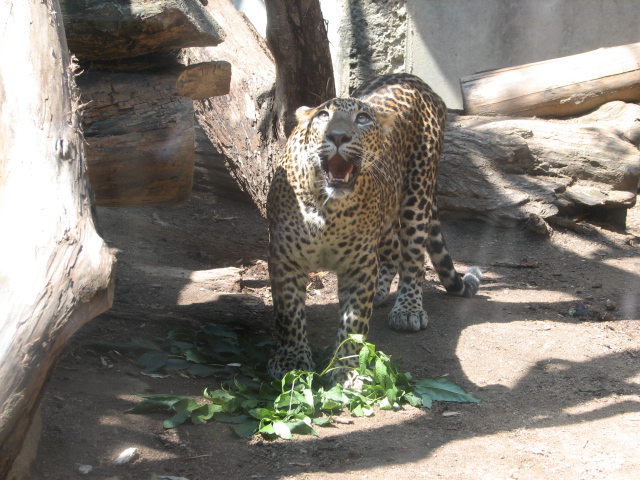- Sri Lanka Leopard
Taxobox

image_width = 240px
image_caption = Sri Lanka Leopard
name = Sri Lankan Leopard
status = EN
status_system=iucn3.1
regnum =Animal ia
phylum = Chordata
classis =Mammal ia
ordo =Carnivora
familia =Felidae
genus = "Panthera "
species = "P. pardus"
subspecies = "P. p. kotiya"
trinomial = "Panthera pardus kotiya"
trinomial_authority =Deraniyagala , 1956 [ITIS|ID=726468 |taxon="Panthera pardus kotiya"|year=2007|date=27 October] The Sri Lanka leopard ("Panthera pardus kotiya"), colloquially known as Kotiya, is a subspecies ofleopard native toSri Lanka . However, "kotiyā" is now the colloquial Sinhala name for the tiger and "diviyā" is used for the leopard. See below for more information. A recent study has shown thatYala National Park has one of the highest recorded densities of leopards in the world, although this animal is still considered to be endangered. TheWilpattu National Park inSri Lanka is also known as a good place to watch leopards. Leopards tend to be more readily observed in parts of Sri Lanka than in other countries where they share their habitat with more dominant competitors, such aslion s orhyaena s.Description
The Sri Lanka leopard is one of the nine known subspecies of leopard. Its coat is tawny or rusty yellow, stamped with dark spots and rosettes. Seven females that were weighed averaged 29 kg; males averaged 56 kg, with the largest being 77 kg. cite book |author=Nowell K, Jackson P |title= Wild Cats: Status Survey and Conservation Action Plan|url=http://carnivoractionplans1.free.fr/wildcats.pdf |format=PDF |year=1996 |publisher=IUCN/SSC Cat Specialist Group |location= Gland, Switzerland |isbn=2-8317-0045-0 |page= 78|chapter= Panthera Leo]
Range and habitat
This leopard is found only in Sri Lanka, and is the country's top predator. Little has been known about it in the past, but ongoing studies (The Leopard Project, run by The Wilderness and Wildlife Conservation Trust, [http://www.wwct.org] ) indicate that they are still distributed throughout the island both inside and outside of protected areas. The leopard has been observed in a variety of
habitat s including dryevergreen monsoon forest, arid scrub jungle, low and uppermontane (highland) forest,rainforest , and wet zone intermediate forests.Feeding
Like most cats, the Sri Lanka leopard is pragmatic in its choice of diet which can include small mammals, birds, reptiles as well as larger animals. Axis or spotted deer make up the majority of its diet in the dry zone. The animal also preys on sambar,
barking deer , wild boar and monkeys. The cat has been known to tackle almost fully grown buffalos.{cn}The leopard hunts like other leopards, silently stalking its prey until it is within striking distance where it unleashes a burst of speed to quickly pursue and pounce on its victim. The prey is usually dispatched with a single bite to the throat.
Biology
A recent study in Yala National Park (The Leopard Project) indicates that Sri Lankan leopards are not any more social, nor less nocturnal, than other populations. They are solitary hunters, with the exception of females with young. Both sexes live in overlapping territories with the ranges of males overlapping the smaller ranges of several females, as well as overlapping the ranges of neighbouring males.
The breeding season is throughout the year with a non-significant peak in the dry season. A litter usually consists of 2 cubs. Unlike some other leopards, Sri Lanka leopards appear to rarely cache kills in trees. This is consistent with other populations where the leopard is the
apex predator as there is no requirement for them to store their prey in places which are inaccessible to other predators.Threats
The survival of the Sri Lanka leopard has been threatened due to poaching, habitat loss, and persecution. Despite these threats, the animal is highly adaptable and is able to live in close proximity to human settlements. Years of civil unrest in Sri Lanka have hampered conservation efforts, especially in the Wilpattu national park and eastern regions contested by government forces and the
LTTE .Conservation
Further research into the Sri Lanka leopard is needed for any conservation measure to be effective. The Leopard Project under the Wilderness and Wildlife Conservation Trust (WWCT) is working closely with the government of Sri Lanka to ensure this occurs. The Sri Lanka Wildlife Conservation Society will also undetake some studies. The WWCT are currently engaged in the central hills region where fragmentation of the leopard's habitat is rapidly occurring.
Misidentification in Sri Lanka
Some years ago, the word 'Kotiya' was mistakenly translated to English as "
tiger " in some Sri Lankan media due to incorrect information received from the then head of the Wildlife Department in Sri Lanka. He had said that "there are no kotiyas in Sri Lanka", misinterpreting "Panthera pardus kotiya" as "Diviya" (cat) in Sinhala. It is correct information that there are there are no tigers ('Viyagraya' in Sinhala) in Sri Lanka. However, theSinhala term for tiger is not 'kotiya' but 'Viyagraya'). "Panthera pardus kotiya" is the kotiyā, and there is no such creature as "Panthera pardus diviya". Unfortunately some Sri Lankans started to use "kotiyā" to mean "tiger", so "diviyā" was chosen for "leopard".The term "diviya" has been used for centuries in Sri Lanka to refer to smaller wild species of the cat family such as "Handun Diviyā" or "Kola Diviyā" (both names for the
Fishing Cat ).One more factor that add to the confusion regarding the kotiya and diviya name collision is that the Liberation
Tiger s of Tamil Eelam orLTTE in Sri Lanka (a militant Tamil nationalist organization currently proscribed as a terrorist outfit) is colloquially known to Sinhala speaking community as 'Koti' (plural form of 'Kotiya')References
External links
* [http://www.arkive.org/species/GES/mammals/Panthera_pardus_kotiya/ Images and movies of the Sri Lankan leopard "(Panthera pardus kotiya)"] from ARKive
Wikimedia Foundation. 2010.
